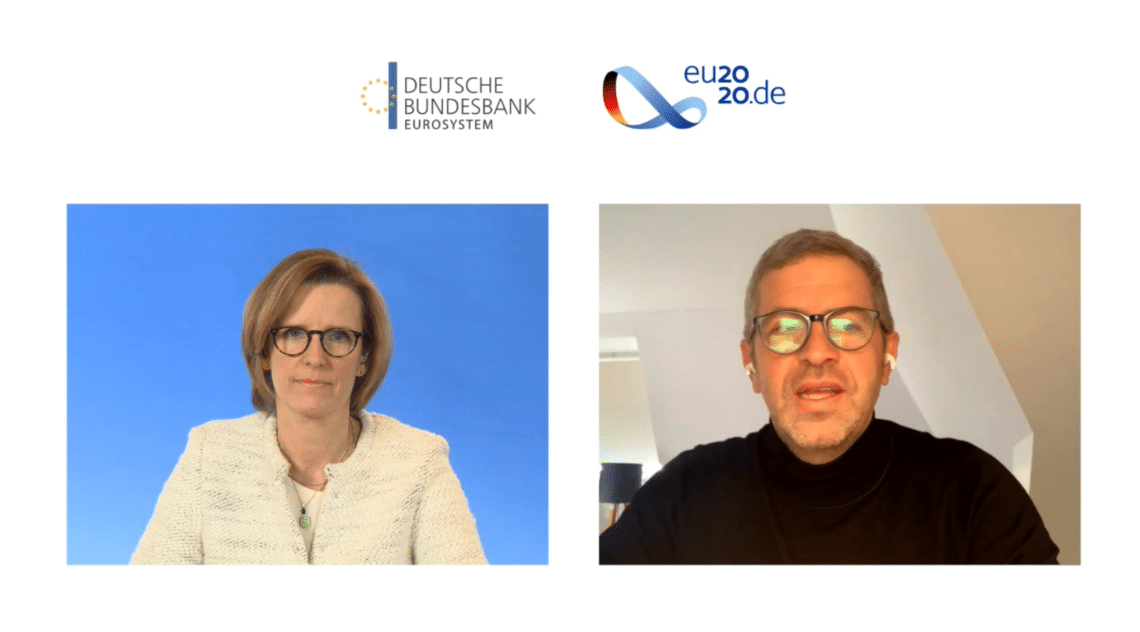Last week, the virtual conference „The future of payments in Europe„organised by the Deutsche Bundesbank. Various perspectives were presented and discussed on the latest developments in European payments, in particular the European Commission’s Retail Payments Strategy, the European Payments Initiative and the European Payments Council. the possible role of a digital euro in the payment landscape.
High-ranking speakers from central banks, politics and industry exchanged views on the evolving digital payments landscape. The conference was opened by Bundesbank President Jens Weidmann and Federal Finance Minister Olaf Scholz. EU Commissioner Mairead McGuinness presented the Commission’s retail payments strategy, which is part of the recently published Digital Finance Package.
Fabio Panetta (European Central Bank), Joachim Schmalzl (EPI), Ignazio Visco (Banca d’Italia) then highlighted the main trends in European payments. In the subsequent panel discussion, Javier San Félix (Santander Group), Gilles Grapinet (Worldline), Jörg Kukies (Federal Ministry of Finance) and Valentin Stalf (N26) outlined the specific challenges for market participants and answered questions from the audience. Burkard Balz, member of the Executive Board of the Deutsche Bundesbank responsible for payment and settlement systems, concluded the conference with an outlook on the future of payment traffic in Europe.
André Bajorat was also invited in his role as a speaker from Deutsche Bank to contribute some food for thought, and moderator Valerie Haller interviewed him on the topic: What digitization in payments really means!
We would like to take this interview as an opportunity to present it to a wider audience.
To start: Everyone is talking about digitalization and probably not everyone is talking about the same things: What do you think is most important to understand when discussing / talking about digitalization?
First of all, there is no difference between women and men in this field :-) Digitization is not an end in itself, and technology alone is not an advantage.
In the case of good digital solutions, they therefore not only digitise but, importantly, improve the product or service itself or facilitate its use or access.

If an analog process wasn’t good, technology alone won’t make it better. Our understanding of digital solutions has changed yet again with the introduction of real smartphones, as we are less and less willing to settle for an average user experience.
As a result, digitization is now often associated with terms like seamless integration, contextualization, convenience, and beliefs like mobile-first.
Long story short: It’s about better solutions for us as users, which often go hand in hand with changed behavior patterns.
Do you see any lessons that banks and/or retailers can learn from the Corona crisis?
Yeah, as an industry we can definitely learn a lot from that.
In the banking world, we have often heard people say in the past why something is not possible or applicable, but suddenly, in the time of need, these „impossible“ product or process improvements were suddenly possible – especially when it comes to digitalization.
Banks and retailers in particular will have to adjust to the fact that customer behavior will change permanently and that even the multi-channel offerings that have been in demand for years will have to be digital from start to finish – with less and less tolerance for interruptions in the processes.

Even the brick enthusiasts have now realized that these are no longer sufficient as stand-alones and that a digital channel is always necessary.
What do you think about future point-of-sale (POS) payments? Will everything be mobile?
We have changed our POS behavior – it is now normal to touch the unknown as little as possible in and through the pandemic.
For payments, this means that contactless payments have passed a tipping point. And mobile means in the broadest sense – the NFC card, as well as the mobile phone, the smartwatch or the payment ring.

This trend will not go away, and the virtualization of the card itself will keep it that way in the future and we will pay with something. A payment function will be integrated into the „something“ – regardless of whether it is a card or a bank account – that is of no interest to the customer as long as it works smoothly and sustainably.
That this solution works in every channel and around the world is the expectation of us as users.
Closed solutions that are limited to silos and/or regions will only have a raison d’être in a few exceptions, as no one will want to think about payment and choose the right card for the location.
„convenience first“ is your mantra when you talk about digital payment? Are other aspects (such as privacy, among others) important from the customer’s point of view?
As much as it pains me to say – no, even if one or the other wishes it. Often other factors such as privacy do not play a big role.
This is where the world power of convenience comes into play, its importance far outweighing and outweighing the other features of payments.
With PSD2, banks have set up APIs (Applied Programming Interfaces). How could this be used as a starting point for open finance (part of the EU Commission’s digital payments package)? (Embedded and invisible finance and banking is the new normal).
I think the better wording is that with PSD2, banks were required to open their systems to third parties via APIs. This opening is definitely a good starting point for „open finance“ and even better for „open everything“.

This requires the mindset of the responsible citizen with authority over his data in the sense of data sovereignty. I believe very strongly in this sovereignty of the individual citizen and I see a great opportunity for Europe as a business location if we succeed in creating a real USP for citizens and companies from this.
What is your opinion on real-time/immediate payments? Could this be a basis for a pan-European payment solution?
Real Time and Instant will be the new normal, but more as part of modern infrastructures than as a product in itself.
And of course this infrastructure can be a basis for a European payment solution -.
but the real product, based on the infrastructure, is the key to success, and real-time is only a small, useful component. The primary homework for a successful European payment system is therefore different.
You can watch the whole conference again here. The interview with André Bajorat starts at hour 2:50. The interview was conducted in English and translated by us.






